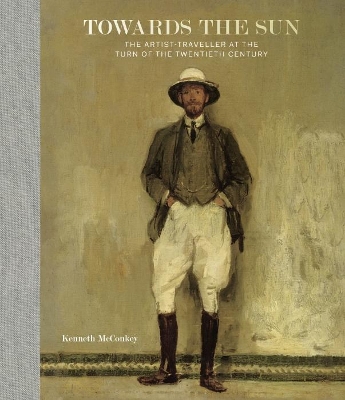While there have been monographs on British artist-travellers in the eighteenth and early nineteenth centuries, there has been no equivalent survey of what the writer, Henry Blackburn, described as ‘artistic travel' a hundred years later. By 1900, the ‘Grand Tourist' became a ‘globe-trotter' equipped with a camera, and despite the development of ‘knapsack photography', visual recording by the old
media of oil and watercolour on-the-spot sketching remained ever-popular.
Kenneth McConkey's exciting new book explores the complex reasons for this in a series of chapters that take the reader from southern Europe to north Africa, the Middle East, India and Japan revealing many artist-travellers whose lives and works are scarcely remembered today. He alerts us to a generation of painters, trained in academies and artists' colonies in Europe that acted as crèches for those would go on to explore life and landscape further afi eld. The seeds of wanderlust were sown in student years in places where tuition was conducted in French or German, and models were often Spanish, Italian, or North African. At fi rst the countries of western Europe were explored afresh and cities like Tangier became artists' haunts. Training that prioritized plein air naturalism led to the common belief that a well-schooled young painter should be capable of working anywhere, and in any circumstances.
At the height of British Imperial power, and facilitated by engineering and technological advance, the burgeoning tourism and travel industry rippled into the production of specialist goods and services that included a dedicated publishing sector. Essential to this phenomenon, the artist-traveller was often commissioned by London dealers to supply themed exhibitions that coincided with contracts for colour-illustrated books recording those exotic parts of the world that were newly available to the tourist, traveller, explorer, emigrant, or colonial civil servant.
These works were not, however, value-neutral, and in some instances, they directly address Orientalism, Imperialism, and the Post-Colonial, in pictures that hybridize, or mimic indigenous ways of life. Behind each there is a range of interesting questions. Does experience live up to expectation? Is the street more desirable than the ancient ruin or sacred site? How were older ideas of the ‘picturesque' reborn in an age when ‘Grand Tours' once confi ned to Italy, now encompassed the globe? McConkey's wideranging
survey hopes to address some of these issues.
This richly illustrated book explores key sites visited by artist-travellers and investigates artists including Frank Brangwyn, Mary Cameron, Alfred East, John Lavery, Arthur Melville, Mortimer Menpes, as well as other under-researched British artists. Drawing the strands together, it redefi nes the picturesque, by considering issues of visualization and verisimilitude, dissemination and aesthetic value.
- ISBN10 1913645088
- ISBN13 9781913645083
- Publish Date 10 August 2021
- Publish Status Active
- Publish Country GB
- Imprint Paul Holberton Publishing Ltd
- Format Hardcover
- Pages 240
- Language English
